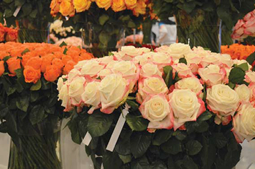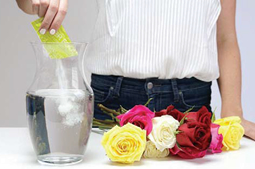 Summer is around the corner, and it will most likely be another record-breaking one. On those blazing hot summer days, you are doing everything possible to stay cool, aren’t you? Well, flowers require the same!
Summer is around the corner, and it will most likely be another record-breaking one. On those blazing hot summer days, you are doing everything possible to stay cool, aren’t you? Well, flowers require the same!
When the heat rises, flowers will – just like people – rapidly start to increase their respiration. The need for water intake greatly increases, to maintain the right temperature and not dry out.
The best treatment for cut flowers is to maintain a constant temperature and avoid extreme heat, cold or drafts. If the temperature does spike, check the water levels and if condensation has developed on the inside of sleeves. Remove sleeves with condensation immediately, to prevent botrytis and other dangers.
Advancements in cold chain management
Adherence to correct temperatures and proper cold chain management are two of the easiest procedures to follow. Test results consistently prove it’s well worth the time and effort.
In the floral industry of 2020, cut flowers are often transported over great distances to ensure that products are available to retailers. Because a majority of cut flowers in Europe are imported from other countries, it’s vital to adhere to proper care and handling procedures. Product quality depends on it.
Fortunately, advancements in temperature technology and cold chain management allow most imported blooms to arrive vibrantly nowadays. Good vase life can be guaranteed in a way that was impossible a mere decade ago.
 Extending the life of flowers
Extending the life of flowers
The cold chain is arguably the most crucial link in the treatment process of flowers, which starts immediately post-harvest. It should remain consistent throughout the flowers’ journey, from farm to transporter to wholesaler, and all the way to the flower shop.
The main factor in this cold chain process is to continually maintain a cool temperature of between 1 to 3 degrees Celsius.
As soon as flowers are picked in the field, the cold chain starts. The post-harvest process means hydrating and treating blooms in a refrigerated room to remove field heat, before they are categorised, bunched and sleeved.
As they leave the farm, the flowers stay cooled. Nowadays, just about all trucks transporting flowers include refrigeration. Even the process of loading them onto the plane is now temperature-controlled. And once the air freight lands, it’s immediately placed in a refrigerated hall at the airport, where customs officials inspect it. Afterwards, it’s back into a refrigerated truck and sent onwards. Consistency is Key.
Although many different people contribute to the journey flowers take, it’s imperative to ensure that their temperature doesn’t vary too much throughout the transportation process.
Avoiding too much fluctuation is so essential because flowers can quickly become stressed when temperatures rise and lower repeatedly. This can cause them to produce ethylene and develop condensation inside the packaging.
Relative humidity also plays a role as water in the air can hurt a flower’s shelf life. Flowers in transit will lose water, resulting in what’s known as “water stress,” which can lead to bent necks and wilting. Relative humidity should be approximately 75-85 percent – anything higher is hazardous.
Cold storage in the shop
Flowers should be placed in cold storage as soon as they arrive in shop – at a temperature equal to what they travelled in.
Only when you are ready to sell them, take them out!
For grocery floral businesses, staff should try to keep flowers separate from produce. Although both need to go through a similar process of cooling, flowers can be easily damaged by the ethylene gas produced by ripening fruit.
Some people still think that temperature control is no longer as important as when the flowers were in transit, but this is a grave mistake. If you want to provide the best quality flowers that keep customers coming back, never forget the essential steps of care and handling:
Best Practices
Sanitation – The importance of cleanliness is underestimated. Studies have shown that dirty buckets can reduce the vase life of a rose by up to 20%. Make sure that everything – buckets, cutters, coolers, benches, and so on – is cleaned with an approved disinfectant cleaner.
Hydrate – For best results when processing dry pack or re-processing flowers, cut and dip in an instant hydrating treatment to jump-start hydration and ensure freeflowing stems. This is a must for roses and Gerberas to help prevent bent necks.
Nourish – After a long journey, flowers need to be nourished and fed. Using a flower food solution will provide flowers with what they need to thrive.
Protect – Use a professional finishing spray to refresh, hydrate and protect your flowers. Quick and easy to apply, this is a final step before your arrangements go out the door. A simple fine-mist spray is all it takes to maximise customer satisfaction and extend the enjoyment of receiving flowers.
Customer care – As a florist, you are the flower expert. So offer customers lots of advice on the steps to follow at home. Educate them about placing flowers in direct sunlight, drafty places, or near heating and cooling vents. Remind them to change the flower-food solution every three days. And always provide enough flower food with every purchase and delivery


